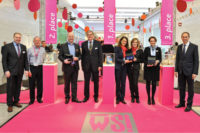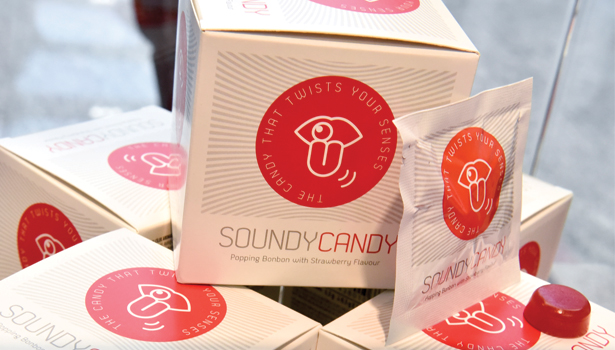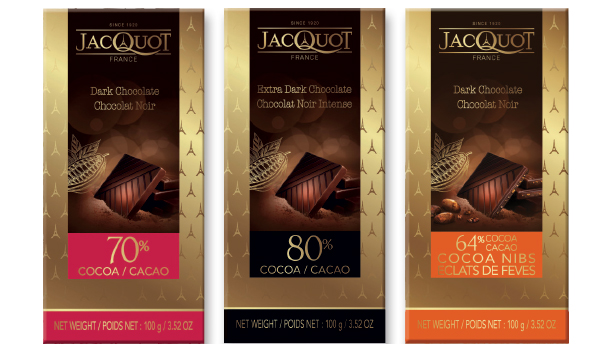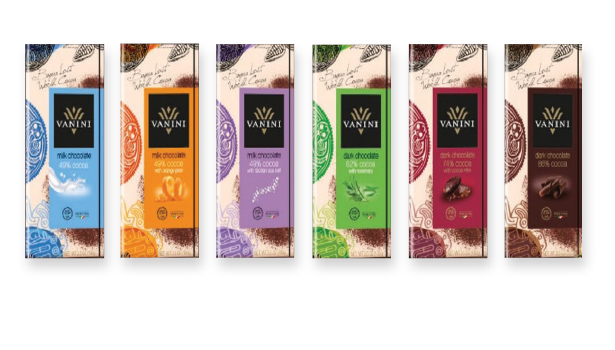ISM: Strong heartbeat drives candy love at ISM
The 45th annual convening of the International Sweets and Biscuits Fair in Cologne reaffirms the future and "heart" of sweets and snacks.






























Let’s do the numbers first. Four days, nearly 40,000 visitors from 141 countries. Oh yes, a six percent increase in attendance from last year’s annual show. Thus, the 2015 International Sweets and Biscuits Fair (ISM) in Cologne reinforced what candy and snack buyers in the industry already knew; namely that sweets and snacks remain top of mind for global consumers everywhere. And the show continues to represent “the future and heart of sweets and snacks,” as its theme proclaimed.
And so, what about those trends? Well, fruit forward, specialty chocolates, portability, sustainability and incredible creativity in flavor, texture and technology. Sound familiar. Of course. What’s different is that many more companies, particularly midsized confectionery operations, are demonstrating a willingness to push the envelope to capture a more discerning, adventurous and engaged consumer.
Take Viba Sweets GmbH’s new fruit bar launch, for example. Long a manufacturer of fruit-focused snacking products as well as chocolate hazelnut items, the company displayed a broader and more exotic range of conveniently packaged fruit snacks at the show.
Seven different flavors, ranging from exotic and familiar fruit combinations such as cranberry-chokeberry (aronia berries), apple-pink grapefruit, pineapple-mango and banana-apple to more familiar and comforting selections such as cream-brittle, multifruit and strawberry-yogurt, accent the new line’s goal of being healthy flavorful, fun and convenient.
“Due to its high fruit content, these bars present themselves in a 35-g. size as the ideal snack: Fruit for the pocket, so to speak,” says Andreas Steffen, Viba’s sales and marketing manager. The bars feature top quality ingredients and no artificial coloring, flavoring or preservatives. Enhanced and protected with wafers, “the snacks are easily unpacked and immediately enjoyable,” he adds. “Viba vitalizes the confectionery bar with a nutritional and physiological valued fruit bar.”
New eye-catching packaging, which is supported by a clever checkout display that suggests fresh fruit baskets at an open air market, emphasizes the idea of “fruit to go,” adds Kathrin Hesselbarth, the company’s export and special accounts manager.
On-the-go consumption, of course, have long been a favorite of consumers, be they meals, drinks or snacks. Seems that The Toms Group has figured out a way to take the confectionery “roadies” concept one step further by combing coffee, chocolate and spirits in its new Chocolate Coffee Liqueurs offering.
Given its legacy — the company that claims to have invented the liqueur-filled chocolate bottle — Toms’ new Anthon Berg line, which features “Irish Coffee with a warming whiskey, a French Coffee with sweet and tangy orange liqueur, a Cuban Coffee with white rum and mild caramel, and finally a Mexican Coffee with a shot of tequila,” adds a new dimension to a familiar treat
As Henning Kallesen, export director for the company points out, “The combination of coffee and chocolate is an evergreen. But coffee itself has also had a comeback and has been reintroduced as a fine food on a much broader scale than ever before. That’s why we believe that now is the right time to launch a coffee version of our successful chocolate liqueur bottles.”
And continuing on that confectionery roadie theme, sans alcohol, Toms also expanded its already popular Anthon Berg Chocolate Sticks line with a Milk Chocolate Stick with Hazelnut variety, joining Dark Sea Salt/Almonds, Dark Chili/Honey/Almonds, Dark Licorice, Milk Nougat and Milk Caramel Crisp flavors.
“We know that self-indulgence on the go is a growing trend as people commute longer distances and live active outgoing lives,” adds Kallesen. “Therefore we have created Chocolate Sticks, which is the perfect sophisticated product to meet this consumption situation and offer a more upgraded alternative to the chocolate bar.”
Each 37-gram stick is scored into seven pieces, making it easily sharable and/or perfect for portion-control consumption. At the same time, the slender shape permits guiltless total consumption.
Toms, however, isn’t the only company venturing into new chocolate niche areas. A. Loacker AG-SpA, which celebrates its 90th anniversary this year, has gone “totally chocolate.”
Long known for its extensive range of premium wafer-based products, the Auna Di Sotto, Italy-based company has — during the past few years — expanded its line of products to include chocolate and wafer-based biscuits, pralines and now, chocolate bars.
The 87-gram bar features “Loacker’s DNA,” says Ulrich Zuenelli, chairman of the company. That DNA, of course, combines wafer bits, tender cream and chocolate into a lighter eating experience.
“The bars have a completely different texture, bite and mouth feel,” he explains. “We take advantage of our core competencies to deliver four wonderful varieties: Milk, Cremkakao, Dark-Noir and White.”
Nine months in development, the bars were launched last fall. Additional newcomers to the Loacker range this year include White Tortina biscuits as well as Loackini, bite-sized, chocolate-coated hazelnut pralines that incorporate… what else, wafers, of course.
2015 will also mark the launch of a new marketing campaign in the United States by Loacker. Last year, the company established a U.S. subsidiary, Loacker USA. This year’s promotional efforts, which were launched at the South by Southwest music, film and interactive festival in early March, will see increased emphasis on sampling,
“It’s a person-to-person sampling program, whereby we ask people to share a Loacker product with a friend,” says Crystal Black Davis, v.p. – marketing. The brand-building campaign is aimed at both existing and new customers and will feature targeted promotions during the holidays.
Of course, there were several other companies also introducing new chocolate bar products at the show. Valor Chocolates, long known for its classic Marcona almond chocolate bars as well as its sugar-free chocolate lines, launched two new lines at the show.
Its Chocolatium bars, available in three varieties — Chocolate Chocolatium 70% dark truffle filling and chocolate cookie, Chocolatium Pure Chocolate hazelnut cream filling and crispy wafer, and Chocolatium Milk Chocolate filled with caramel cream delicious cookies — are designed to delight consumers with the finest cocoas integrated with familiar textures. It combines confectionery and pastry skills into one bar, creating a “sum of all pleasures.”
The company has also rolled out “Crocan,” anther melding of textures and flavors in a 3.2-oz. size aimed at a younger clientele. The three varieties include: Milk chocolate with Caramel Cream and Cookies, Milk chocolate with Crunchy Corn Nuts and Milk chocolate with Apple pie.
Last but not least, Valor has switched to using stevia for its sugar-free chocolate line. New varieties for the sugar-free, 3.5-oz bar include Creamy Hazelnut, 70% Dark Chocolate with Orange Cream and the Dark Truffle Cream Bar.
Chocolate aficionados looking for something single-origin can turn to Lecco, Italy-based ICAM Cioccolato SpA. The company was touting its premium Vanini brand, which uses single-origin Amazonia Bagua cocoa. According to ICAM, Bagua cocoa is regarded as one of the world’s most ancient cocoas. It was grown as early as 3000 B.C. by the Mayo-Chincipe people who used it to produce drinks long before the Mayans and the Olmecs.
The recently launched 100-g. bar line features the following varieties: Milk Chocolate Bagua Cocoa 49%; Milk Chocolate Bagua Cocoa 49% with Sicilian Salt; Milk Chocolate Bagua Cocoa 49% with Orange Peel; Dark Chocolate Bagua Cocoa 62% with Rosemary; Dark Chocolate Bagua Cocoa 74% with Cocoa Nibs; and Dark Chocolate Bagua Cocoa 86%.
The company also debuted its “GoDo” line at the show, which is organic and also features a sugar-free variety. In Italian the word GODO means to enjoy sensual pleasure, so that that the great taste of the chocolate becomes an integral part of enjoying life. The bars now come in a larger 85-g format and sport a new packaging design.
Camille Bloch, which has been producing chocolate in Switzerland since 1929, also introduced a new companion to its classic line of Ragusa chocolate bars, “Blond.” The new variety takes white chocolate’s popularity one step further through caramelization, thereby turning the traditional white color associated with white chocolate into a caramel blond.
The bar, which uses caramelized milk powder, a truffle filling and whole hazelnuts, follows the same formula as the original Ragusa varieties in Classique and Noir flavors. Developed in 1942 by Camille Bloch when cocoa was in short supply, the chocolatier processed ground hazelnuts into a paste and then added whole hazelnuts. He then spread the paste in flat moulds and covered both sides with a thin layer of chocolate. Once demoulded, the chocolate slabs were cut into bars. Their ensuing popularity has earned the Ragusa brand the moniker, “the Swiss cult chocolate.”
Regardless of the color, be it dark, milk or white, cocoa sustainability was on the minds and packages for many chocolate products at ISM. One of the companies that announced a major new initiative was the CEMOI Group.
Dubbed Transparence Cacao, the move has CEMOI committed to investing €20 million during the next three years to ensure 100 percent of its cocoa supplies, about 145,000 tons sourced from 60,000 farmers and four major origins. Working with The Forest Trust (TFT) group, the company will establish three levels of quality for its cocoa products: reference, preference and excellence.
“There will be four criteria to determine quality, starting with food quality, quality of the aroma, quality of farmer life and environment quality,” explained Patrick Poirrier, CEMOI’s ceo. With the help of TFT, the company looks to bring more responsibly grown products onto the market, building the program on three pillars: to know, to transform, and to verify. Noting that the company remains a family company going back three generations, Poirrier pointed out that transparency is part of the company’s DNA.
“We visit farmers at the origins, we never outsource,” he said. Moreover, “We know who are the farmers, the quality of the product, the revenues earned and the need to learn new techniques.”
Poirrier revealed that the company will be reporting publicly each year on its progress.
Of course, the company also unveiled a whole slate of new products developed for the export market. Some of the new items include the following: Les Truffles Créatives, fancy raspberry crumble truffles that combine the crunchiness of biscuits with a sharp raspberry flavor; special Valentine’s Day heart-shaped tins displaying images of Paris, the city of lovers and containing three heart-shaped chocolates; special Mother’s Day marshmallow hearts in a heart-shaped tin containing three chocolate-covered marshmallows; a new GOLD range of premium, cocoa-rich dark chocolate bars in three intense recipes — 80% cocoa solids, 70% cocoa solids and 64% cocoa solids with cocoa nibs — and chocolate specialties, which feature a delicious whole hazelnut nestling inside a creamy and crunchy cereal center that’s encased in a chocolate shell.
New product development continues unabated within the sugar confectionery sector. At Katjes Fassin GmbH, the push toward vegetarian-based gummies remains strong. Tobias Bachmüller, managing partner of Katjes, reiterated that the company’s focus is all about “re-establishing the message about going green.” Nearly 80 percent of company’s gummi products are now vegetarian.
Bachmüller remains bullish about the company’s growth, noting that his goal of doubling revenues every five year was accomplished in four years. Steady internal growth ranging between 5 to 10 percent coupled with timely acquisitions — the company purchased Piasten last October, Germany’s largest manufacturer of sugar-coated products — has been the formula.
Meanwhile, at the Mederer Group, there are, besides the usual creative new product offerings, some changes. Nicolas Mederer, Hebert Mederer’s son, will become one of three chief executive officers of a six-person executive team.
Hebert will remain as chairman and focus on product development and overseeing technical innovations in manufacturing. Mederer indicated that the transition plan had been in the works for five years and that the move will provide him with a bit more free time.
Nicolas says he’s looking forward to the challenge after being the general manager of the Mederer Group’s Spanish operation in Valencia, Spain. At the same time, he admits it’s a bit “frightening” to take on the new responsibility.
Those internal changes didn’t stop the Mederer Group from launching several innovative gummi products at ISM. First, there’s Trolli Bunte Kuh or Colorful Cow. The cow’s quaint forelock, loyal expression and bright red fruit-gum nose, provides a soft marshmallow fruity treat that’s also vegetarian. The cows come in lemon, strawberry, lime, cherry, red orange or red berry flavors.
For gummi lovers looking for a bit more excitement, Trolli offers its Fizzy Mouse variety. Heavy on cuteness, the pink, white or blue mice serve up a tingling surprise. Coated in sherbet powder, the fruit flavor of raspberry, tutti-frutti, lemon or pineapple tartly tickles the tongue.
Another innovation at Trolli are Saft Michel gums. A berry red cap filled with fruit juice and plenty of vitamins sit over the troll’s button eyes. His bright fruit gum shoes, are not only truly eye-catching, they allow him to even stand upright, The company uses an innovative, multi-stage manufacturing process to create this jolly fellow to deliver fruity, vitamin-rich taste explosion of orange, apricot, apple, lemon, mango, banana, guava, nectarine, grape, mandarin, peach, passion fruit, kiwi, papaya, grapefruit and pineapple flavors.
And for those looking for fruit on the go, Trolli offers its saucy little Fast Food fruits made with a 40 percent fruit component, comprising of juices, pulp and extracts.
As Janice Joplin would belt out, “…come on, come on, come on, come on and take it!
Take it! Take another little piece of my [confectionery] heart now, baby.”
Looking for a reprint of this article?
From high-res PDFs to custom plaques, order your copy today!




















